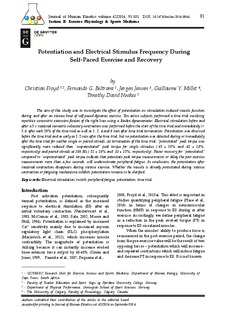| dc.description.abstract | The aim of this study was to investigate the effect of potentiation on stimulation-induced muscle function during and after an intense bout of self-paced dynamic exercise. Ten active subjects performed a time trial involving repetitive concentric extension-flexion of the right knee using a Biodex dynamometer. Electrical stimulation before and after a 5 s maximal isometric voluntary contraction was performed before the start of the time trial and immediately (< 5 s) after each 20% of the time trial as well as 1, 2, 4 and 8 min after time trial termination. Potentiation was observed before the time trial and as early as 1-2 min after the time trial, but no potentiation was detected during or immediately after the time trial for neither single or paired stimuli. At termination of the time trial, “potentiated” peak torque was significantly more reduced than “unpotentiated" peak torque for single stimulus (-65 ± 10% and -42 ± 18%, respectively) and paired stimuli at 100 Hz (-51 ± 10% and -33 ± 15%, respectively). Faster recovery for “potentiated” compared to “unpotentiated” peak torque indicate that potentiate peak torque measurements or delay the post-exercise measurements more than a few seconds, will underestimate peripheral fatigue. In conclusion, the potentiation after maximal contraction disappears during intense exercise. Whether the muscle is already potentiated during intense contraction or fatiguing mechanisms inhibits potentiation remains to be clarified | |
